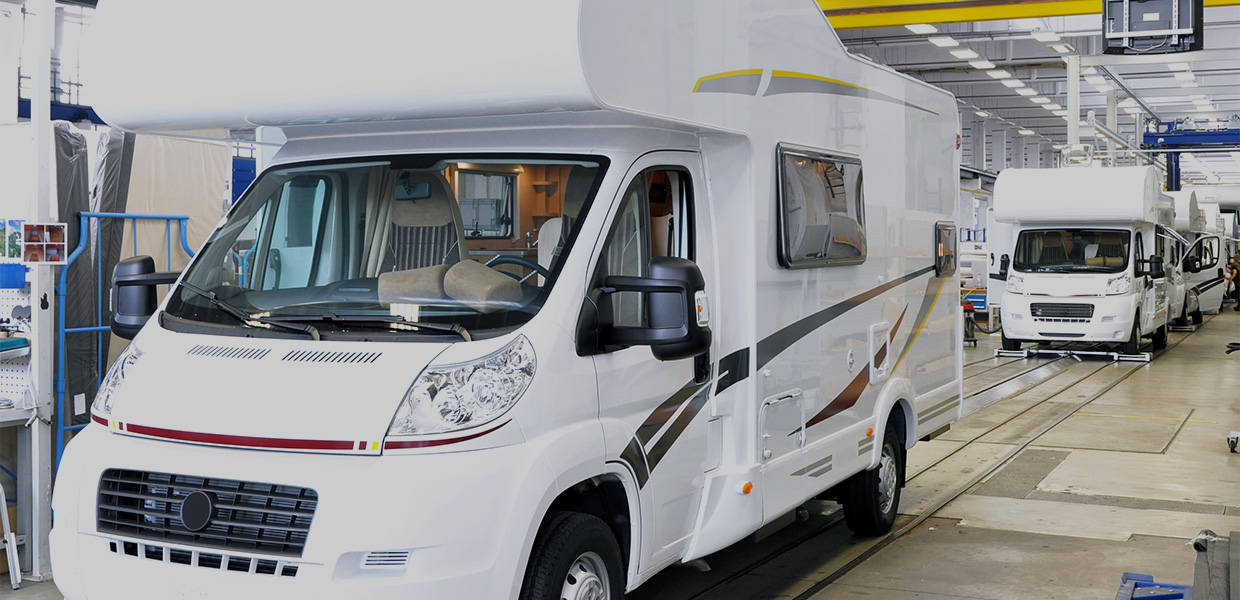From One Extreme to Another
All of this, of course, is a dramatic turnaround from March, when the initial waves of the pandemic forced Elkhart, Ind.-based Thor Industries, Inc., Forest City, Iowa-based Winnebago Industries, Inc. and other companies to temporarily shut down their factories, idling thousands of employees and sending shock waves throughout the North American RV industry.
Hyland said the speed with which the pandemic affected the RV industry caught everyone off guard.
“In 2019, the industry was continuing to work through higher than desired inventory levels in some areas, but felt optimistic about 2020 prospects. The first few months started out well, but no one could have predicted the year we would have, and dealers faced challenges once the pandemic hit and businesses closed,” he said.
Some lenders responded to the sudden downturn by giving dealers more time to pay back their floorplan loans, including Wells Fargo CDF. “As states began to shut down businesses in the early phases of the pandemic, CDF saw an opportunity to help dealers by deferring some of the payments due in an effort to support liquidity needs. This helped bridge the gap until businesses could reopen,” Hyland said.
Northpoint Commercial Finance waived all curtailments due or that would come due during a critical period between April and July. “We also extended aged unit maturities that would have been due in full during these same four months out to the middle of August,” Olander said, adding, “The program was very much appreciated and proved to be extremely beneficial for the dealers in many different ways.”
TCF Bank also provided dealers with several forms of payment relief during the early months of the pandemic. “The biggest action we implemented this year was spending more time listening and staying close to our customers,” Rivera said. “We wanted to make sure we were supporting them in any way we could, from deferring payments, to supporting the Paycheck Protection Program and restructuring payment plans to help them weather the pandemic uncertainty.”
While Rivera noted that some dealers actually declined TCF Bank’s offer to defer payments, others clearly benefitted from the temporary waiving of curtailments last spring, when the pandemic had shut down most businesses across the country, creating immediate economic uncertainty as millions of Americans faced layoffs and furloughs.
By late April, an Outdoor Recreation Roundtable (ORR) Survey of over 100,000 businesses— ranging from RVing and camping to boating and fishing to hunting and biking— found that the pandemic had had a “traumatic effect” on every sector of the outdoor recreation business, according to Jessica Wahl, ORR’s executive director.
Jay Landers, RVIA’s vice president of government affairs, was optimistic, however, telling RV Business in response to the ORR survey that the RV industry was well positioned to withstand the pandemic, noting “the potential for RVs to be the ideal way to travel while adhering to social distancing once it is safe to travel again.”
By June, it was apparent that the RV industry would, indeed, turn around, and it did so faster than many anticipated as hundreds of thousands of consumers began to flood dealerships across the country, purchasing towable and motorized RVs, which they rightly believed would provide them with the safest way to travel and escape the monotony of cabin fever during a pandemic that had put most other travel and entertainment options off limits.
RVIA economists documented 2020’s incredible market volatility with some of the most dramatic quarterly changes in market outlook over three quarters in the history of the RV business.
In February, Dr. Richard Curtin of the University of Michigan predicted 410,100 RV shipments in 2020 for the RV Roadsigns newsletter, a 1% increase over the 406,100 units shipped in 2019. By June, as stay-in-place orders were lifted and consumers flocked to RV dealerships in increasing numbers, Dr. Curtin predicted RV shipments would rebound, but finish out the year at 321,600 shipments, down 20.8% from 2019’s performance.
With 41 years of experience providing shipment forecasts for RVIA, even Dr. Curtin underestimated the strength of the RV industry’s rebound. But it was welcome news for RV dealers, who were facing the prospect of an economic disaster only a couple of months earlier.
“Coming out of the mid-March to mid-May timeframe, dealers have generally been performing well,” Hyland of Wells Fargo CDF said. “From a portfolio perspective, we have seen strong turns, low aging and good margins. The critical factor now is the availability of inventory as strong demand continues and manufacturers work to support that demand.”
Overcoming Growing Pains
Indeed, RV industry lenders say one of the biggest factors limiting their own growth right now is RV manufacturers’ inability to produce new towable and motorized units fast enough to keep up with demand, a problem that partly reflects their difficulties obtaining enough needed parts and supplies.
“The pandemic has disrupted our professional and personal lives,” said Rivera of TCF Bank. “It took us by surprise and we needed to react and adapt, just as our customers and business associates did. The RV industry is thriving through the pandemic as families embrace the outdoors. From all we have heard, it was common for families to cancel their traditional vacations and, instead, acquire or rent an RV. There is practically no inventory left with our dealers, and all new shipments are pre-ordered and backlogged. The greatest challenge now is meeting demand.”
Even used RVs have sold at high rates, which means there is little inventory left to finance, Rivera said. “This year, our inventory financing balances are down compared to the previous year, but it is encouraging to see a strong consumer demand and healthy dealers. As production normalizes, the inventory should return to normal levels, so we see a promising future,” he pointed out.
For his part, Olander of Northpoint said dealers rebounded quickly from the uncertain early months of the pandemic. “Inventory payoffs from RV dealers continues to be tremendously robust and has certainly kept up the vigorous pace set over the summer months and into mid-September,” Olander said. “We have witnessed unprecedented sales and liquidations of RV units coming off dealer credit lines at just an amazing clip through June, July and August. We look forward to a steady restocking of inventories over the coming months and are happy for the dealers and all of their successes over the past months.”
Poised for Record Performance
By late September, when ITR Economics produced its inaugural forecast for RVIA’s quarterly RV RoadSigns report, the Manchester N.N. firm predicted 424, 400 shipments for 2020 – a 4.4% increase over the 406,600 shipments reported in 2019 – and 507,200 units for 2021, the highest shipment figures in the history of the recreational vehicle business.
While lenders are not going so far as to suggest that 2021 will be the strongest in history, they are seeing a number of factors that will continue to fuel strong consumer demand for RVs not only next year, but for many years to come.
“Once people experience the RV lifestyle, they tend to stick with it, and will likely own more than one RV in their lifetime,” Hyland said. “RVing supports the active lifestyle that many people crave, with increased flexibility that other forms of travel are unable to provide, and allows them to see numerous destinations in a cost-effective way. It’s true the pandemic has increased the volume of first-time buyers as friends and families seek new ways to safely spend time together, but we don’t expect this trend to be short lived. This should have a positive, long-term effect on the industry.”
Rivera is also optimistic about the long-term health of the RV industry, despite several immediate challenges. “We look at two things: supply and demand. Many of our customers continue to voice challenges with the supply chain. Parts and components reportedly are scarce. Many customers predict they will continue to face these challenges for an extended period of time, probably into the third quarter of 2021.”
RV demand, meanwhile, will be affected by the overall health of the economy, unemployment and government support programs. “The industry has done a great job diversifying the products and price points, attracting new customers and promoting the outdoor lifestyle. In our view, all of those factors should contribute to driving sustainable growth for many years,” Rivera related.
Rivera added that the pandemic has opened up people’s eyes to the fact that, in many cases, they work remotely from an RV. “Why not join your meetings or talk to your customers from a campground?” he asked. “As long as you have good connectivity, you can be effective doing your job or participating in school activities while enjoying nature.”
“For the industry, I think there is reason to be optimistic,” said Lax of Bank of the West. “RVs are great products that are well-received by consumers, and the industry has done a great job of promoting the benefits of RVing, particularly during this uncertain time. At Bank of the West, we’ve made significant investments in our RV business that have positioned us for growth. We are going to be introducing enhancements to our program in the coming months.”
The biggest limitation to short-term RV industry growth are issues involving the supply chain. “The pandemic caused component and parts shortages that are integral for the completion and repair/maintenance of an RV,” Lobo of DLL told RV Business. “So, in addition to the retail consumer demand for finished product, there is also more demand for what can be produced and supplied through the supply chain. Inevitably, in due time, the market demand and supply equilibrium will be re-established once COVID-19 uncertainties have been mitigated.”
DLL, meanwhile, looks forward to growth opportunities with the RV dealer base. “Whether it is establishing lines of credit, increasing product flow through stock inventory or filling the equipment showroom without tying up balance sheets or credit lines, our dedicated team will work with dealers and manufacturers to grow their business,” Lobo said.


